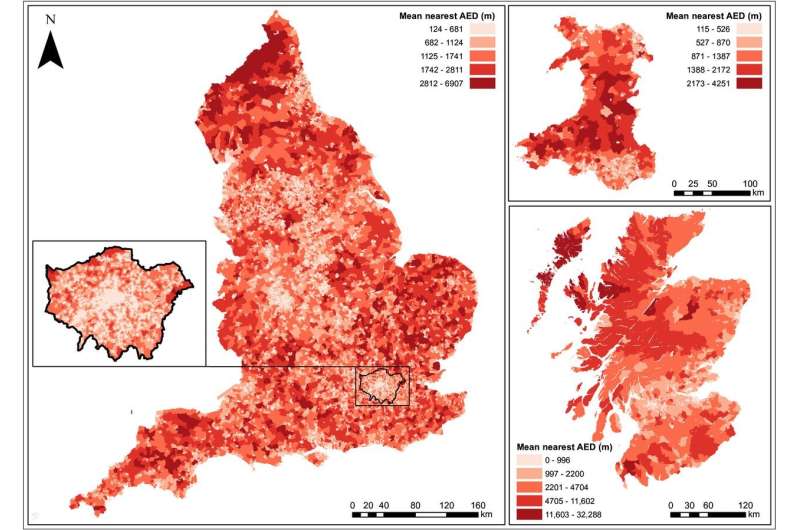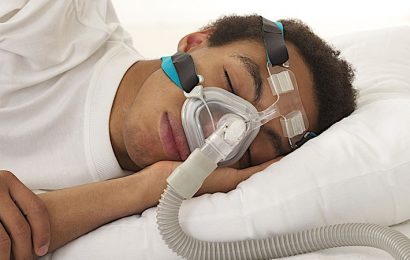
In the most deprived areas of England and Scotland, the nearest 24/7 accessible defibrillator is on average a round trip of over a mile, or 1.8km, according to research supported by the British Heart Foundation (BHF). The pioneering study—one of the biggest ever to look at defibrillator access—is published in the journal Heart and presented today at the European Society of Cardiology Congress in Amsterdam.
The researchers, using data from The Circuit: the national defibrillator network, calculated the median road distance to a defibrillator with unrestricted public access in Great Britain’s 1.7 million postcodes, and studied the relationship between the distance to a defibrillator and an area’s level of deprivation.
In Wales, there was no link between defibrillator location and deprivation, but the picture in England and Scotland revealed that on average, the more deprived an area is, the further it is from a 24/7-accessible defibrillator. With nearly three in 10 out-of-hospital cardiac arrests happening on the weekend and four in 10 between 6pm and 6am in England, quick access to a defibrillator at any time of the day is crucial.
People living in the most deprived areas of England and Scotland are on average 99 and 317 meters further away from their nearest 24/7 defibrillator than those in the least deprived areas, respectively.
On average, a public access defibrillator is 726 meters away from the center of any given postcode along the road network across Great Britain.
Every minute of delay between a cardiac arrest and defibrillation reduces the chance of survival by up to 10 percent. Quick CPR and defibrillation is vital to give someone the best chance of survival.
This in-depth study sheds new light on alarming health inequalities, with fewer 24/7 defibrillators in close proximity to people living in more deprived areas. The postcode a person lives in may have an important impact on their or a loved one’s chance of surviving a cardiac arrest. The researchers say that the greater distances between defibrillators in more deprived areas are putting lives at risk.
The findings come as the BHF reminds the public to call 999 immediately if they see someone having a cardiac arrest. Anyone can use a defibrillator and you don’t need training. The device checks the heart rhythm and will only tell you to shock if it’s needed. You can’t shock someone accidentally.
Dr. Chris Wilkinson, Senior Lecturer in Cardiology at Hull York Medical School and Honorary Consultant Cardiologist, who led the research, said, “By calculating how far every postcode in Great Britain is from its nearest defibrillator, we’ve shown just how much deprivation levels affect the public’s access to these lifesaving devices out-of-hours in England and Scotland. Making existing defibrillators accessible to the public 24/7 would make a big difference to the average distances people need to travel in an out-of-hours emergency, and would improve equality of access—which can help save lives.”
Judy O’Sullivan, Director of Health Innovation Programmes at the British Heart Foundation, said, “We are proud that data from The Circuit has helped to highlight that deprived communities need better support to help improve response times to an out-of-hospital cardiac arrest. Bystander CPR and defibrillation can double the chance of survival from a cardiac arrest, so it is crucial that we address the unequal access to defibrillators in order to improve survival rates.”
Michael Bradfield, Director of Clinical and Service Development at Resuscitation Council UK, said, “It’s vital that we address the inequalities that exist in terms of where 24/7 accessible defibrillators are located, because CPR along with defibrillation can significantly increase chances of survival following a cardiac arrest. It’s crucial that everyone, no matter where they live, has access to a defibrillator and understands that they are easy to use, no specialist training is required.”
Adam Greenwood, Community Engagement Manager for St John Ambulance, said, “Across the country St John volunteers see the lifesaving impact defibrillators make, daily, but as it stands, our latest research found 47% of people still don’t know where to find their nearest defibrillator.”
“More work is needed to help increase cardiac survival rates and access to defibrillators, especially in deprived communities. These devices are simple and easy to use, and everyone should have equal access to them.
“Our Community Advocates do great work supporting people locally by helping them identify where their nearest devices are and equipping them with the confidence to use one in an emergency. But I’d urge everyone to keep themselves and loved ones safe by learning lifesaving skills, so you could help save a life one day.”
Chris Gale, Professor of Cardiovascular Medicine at the University of Leeds, who co-authored the study, said, “Our research shows that community defibrillators are not an option for many people who suffer cardiac arrest, especially those living in areas of deprivation. This is putting lives are at risk. Urgent action is needed to give everyone the same access to these devices, which will prevent unnecessary deaths.”
Register your defibrillator
For the first time, researchers had access to the location and hours of access of defibrillators all across England, Scotland and Wales. This was only made possible thanks to data from The Circuit, the national defibrillator network, which was developed by the BHF in partnership with Resuscitation Council UK, St John Ambulance, and the Association of Ambulance Chief Executives.
The Circuit’s aim is to map all public access defibrillators in the UK, so ambulance services can direct bystanders to the nearest defibrillator in the event of a cardiac arrest—the ultimate medical emergency. With over 30,000 out-of-hospital cardiac arrests each year in the UK and a survival rate of less than one in ten, quick CPR and defibrillation is vital to improve survival rates.
The BHF and its partner organizations are encouraging anyone with a defibrillator to register it immediately so that the device is visible to ambulance services. This could potentially shorten the distance to your postcode’s nearest defibrillator that’s visible to ambulance services, and could even be the difference between life and death in the event of an out-of-hospital cardiac arrest.
Pam’s story
Pam Shurmer from Hartlepool is the Patient and Public Involvement co-author of the research. She and her husband Bill lost their son Danny Shurmer to cardiac arrest in 2021. Danny was a much-loved cricketer and popular member of his community when he passed away aged 43.
Pam and her husband Bill along with their other Trustees set up the charity DS43 Community Defibrillators in memory of Danny, which fundraises to strategically place Public Access Defibrillators across Hartlepool. They’ve been tireless campaigners in increasing access throughout the town and they aim wherever possible for everyone in Hartlepool to be within a 350m radius of their nearest defibrillator.
Pam said, “I would never want any parent to go through the loss that we went through when Danny passed away. He had no previous health issues and was a talented sportsman, so a cardiac arrest can happen to anyone. The charity is doing all it can to improve access to defibrillators across Hartlepool and we want anyone who has a cardiac arrest to have the best chance of survival.”
“I proudly support this research that highlights just how far the nearest defibrillator is and how unequal the access is. Hopefully this leads to better access to these lifesaving devices.”
More information:
Thomas Burgoine et al, Automated external defibrillator location and socioeconomic deprivation in Great Britain, Heart (2023). DOI: 10.1136/heartjnl-2023-322985. heart.bmj.com/content/early/20 … heartjnl-2023-322985
Journal information:
Heart
Source: Read Full Article


